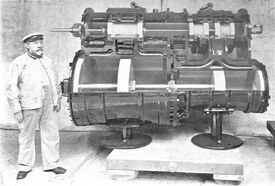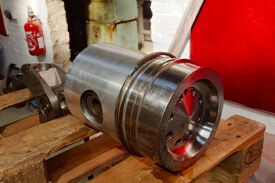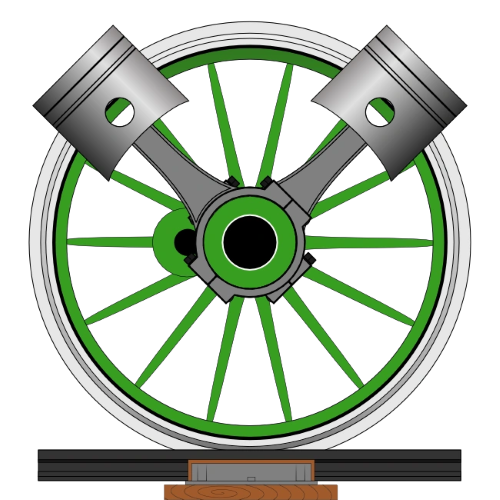
The pistons of a steam locomotive can be seen inside the cylinders (lower) at the mid-way point, of this cut away engine. This tandem compound steam engine is from a Santa Fe 2-10-0 "Decapod" locomotive.
Pistons are used to propel steam locomotives and diesel locomotives. In steam locomotives pistons are forced back and forth by high-pressured steam. Inside a diesel locomotive's engine, pistons create the pressure that induces combustion.
Steam Locomotive[]
Pistons are used in a steam locomotive to transfer the heat energy of the steam, into mechanical energy for motion. This is done via the expansion of heated steam pressing against the piston inside a cylinder. When valves let steam into the gap to one side of the piston, the steam expands forcing the piston to the other end of the cylinder. Once there, valves let steam into the gap on the other side of the piston and the original steam is exhausted by the 'fresher' expanding steam forcing the piston back in the other direction. The spent steam is let out of the cylinder by the valves.
Diesel Locomotive[]

This is a diesel locomotive's piston and connecting-rod from its internal-combustion engine. The piston is the cylindrical component (foreground). The hole through the piston is the pin, called a gudgeon pin, that attaches it to the connecting-rod (background).
Photo by Frédéric Bisson.
- Main article: Diesel engine
Similar to steam locomotives, pistons in the internal-combustion engine of a diesel locomotive are used to convert chemical energy into mechanical energy, but from fuel-oil and via an explosion rather than the steam and expansion of a steam locomotive.
The pistons of a diesel engine are much more complicated than the equivalent pistons in a steam locomotive. This is due to the extreme temperatures, and high-wear factors inside a diesel engine. The piston is a cylinder cast from steel or aluminum alloy, and is slightly smaller than the cylinder walls. It is assembled from a body, a head (or "crown"; closes the top end), piston rings and a skirt.
The piston body is almost entirely covered by external components, but there is room enough for grooves to be cast in the body for the piston rings. The piston rings (see image, right) are multiple metal rings designed to keep the combustion-chamber separated from the rest of the engine. The top-most ring is usually made of chrome to stop carbon — made by the combustion process — from attaching to it. The next rings are made of steel and are designed to stop the exhaust gases from exiting the combustion-chamber past the piston. Below the piston rings and near the bottom of the piston, on the skirt, there are some scraper-rings. When the piston is moving towards the cylinder head, these rings distribute lube-oil onto the cylinder walls and remove said oil when the piston moves away from the cylinder head. The piston skirt is designed to protect the gudgeon pin (see image, right), and to be a platform for the bottom scraper-ring in some cases.
The gudgeon pin connects the piston to the connecting-rod.
Other Uses[]
Pistons are used in many ways in locomotives, including the brakes, suspension, pumps etc., mostly when fluid or air needs to be moved around. The most important use of pistons in electric locomotives is their use in pantographs.
References[]
- Encyclopædia: "Gasoline engine." (Pistons section.) Encyclopædia Britannica Deluxe Edition. Chicago, 2010.
- Book: The Railway Data File. Published by Silverdale Books (2000). ISBN: 1-85605-499-3.
